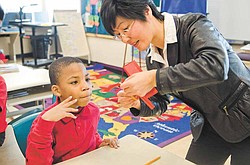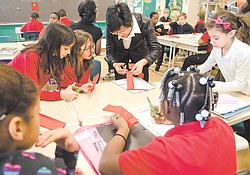Chinese educators learn here
The Vindicator (Youngstown)
Jordan Weatherly, 9, gets personal instruction from Nancy Zhang during the Chinese paper-cutting lesson.
The Vindicator (Youngstown)
Visiting Chinese educator Nancy Zhang demonstrates the traditional art of Chinese paper-cutting in a fourth-grade classroom Tuesday morning at Campbell Elementary School. Zhang and fellow educator Judy Teng arrived here Feb. 4 and will go back to China Friday.
By Jeanne Starmack
CAMPBELL
Education has gone global at Campbell schools.
Two visiting Chinese educators have learned valuable lessons here, while students in a fourth-grade classroom at Campbell Elementary Tuesday morning learned that the Chinese language is a lot like art.
Judy Teng and Nancy Zhang have been staying with Campbell Elementary School Principal Robert Walls since Feb. 4 and have been visiting the schools every day. They came a long way to learn new ideas and will take those ideas with them when they leave Friday for their homes in cities south of Shanghai in eastern China.
The two took time out Tuesday morning to reflect on what they’ve learned during their visit here as they follow the same course Walls took when he visited schools in their Chinese province of Zhejiang in 2007.
Zhang, a vice principal at a foreign-language school called Xiangshan in the city of Ningbo, invited Walls there after Teng came to Campbell schools while she was a visiting scholar at Youngstown State University for a short time in 2007.
“A professor took me here to Campbell, and I was deeply impressed,” Teng said.
Zhang asked her to develop a sister school, she said, so she set up that relationship with Campbell.
Teng, an associate professor of English who teaches but also designs programs for teacher-trainees at Hangzhou Normal University in the city of Hangzhou, said China has come a long way economically. There is still work to be done in its educational system, however, she said.
“China is developing in many ways, but you are a developed country,” she said.
“So I came here to learn from you.”
She said Walls has been an example of a good principal who has connections with the community. “He is a principal with a big heart and a big vision,” Teng said. “We’ll tell teachers [about him] there, because they are future principals.”
Zhang said the two were impressed by museums in this country — they took a trip to the Smithsonian in Washington, D.C. — and they talked about using the museums in China more as an educational resource.
In China, rural schools in poor provinces are at a particular disadvantage in regard to resources, the two said. Schools in the cities and richer provinces tend to have better teachers, better equipment and class sizes that top out at 30. In a poor, rural district, class sizes of 60 or more are the norm as fewer schools means more crowding, they said.
Teng said China puts a lot of money into education. “But we need to develop more resources and programs to make teaching more effective,” she said.
The United States also can learn from China.
“China is a traditional country,” said Zhang, and it has traditional philosophies.
The Confucian philosophy of education, which dates back 2,000 years, holds that teachers should teach according to students’ differences — tailoring teaching to individual needs, Zhang said.
“We need to mix our cultures and enlighten ourselves. Education should be global, not just ‘yours’ and ‘mine,’” Teng said.
She made good on her word, as she and Zhang took a trip from the elementary school’s main office to Linda Vratko- vich’s fourth-grade class. There, Teng asked students: “You see our words — like boxes. What did you think of them?”
“It’s like art,” answered Nicholas Pikos, 10.
Yes, Teng said: Writing words in Chinese is like drawing pictures, and pronouncing them is like music.
In 15 minutes, Vrat- kovich’s students learned how to count to five and how to draw the words for person, people, tree, and forest.
Zhang took over, teaching them the traditional art of Chinese paper cutting. They learned to cut out the word for “really, really happy.”
How did the students like their glimpse of a culture and a language on the other side of the world?
“I thought it was a little bit hard, but it was really fun,” said Jada Cadet, 9.
“I liked the words and numbers best. The numbers were fun,” said Joseph Sebest, 9.
Yes, said Craig Ranaza, 10 — he’s interested in learning Chinese.
 43
43


